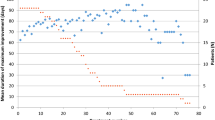Abstract
Treatment with botulinum toxin-A is recommended as first-line treatment for cervical dystonia (CD). In clinical practice many factors appear to influence dose adjustment and the retreatment regimen; however, there is little information available in the literature regarding the evolution of dosing over treatment cycles. We report on two similarly designed, long-term, multicenter, open-label extension studies of Dysport for the treatment of CD, which followed 500 U fixed-dose placebo-controlled trials. Both studies specified a fixed 500 U dose for the first open-label treatment cycle, with dose adjustment in subsequent treatment cycles according to the clinical response. These analyses include 218 patients who entered the two studies; doses in the subsequent treatment cycles ranged between 250 and 1,000 U. During open-label treatment, all treatment cycles resulted in improvements in mean Toronto Western Spasmodic Torticollis Rating Scale (TWSTRS) total scores. However, increasing the dose of Dysport above the initial 500 U dose was not observed to result in an incremental improvement in response as measured by the TWSTRS. No individual patient characteristic was found to reliably predict the use of higher doses at each treatment cycle. Dysport was generally well tolerated with no major differences in the incidence of adverse events (AEs) observed with different doses. Dysphagia was considered an AE of special interest and dysphagia data from the open-label studies were combined with two Phase II studies. Analysis of this enhanced database indicates that unilateral injections of >150 U into the sternocleidomastoid muscle is associated with a higher dysphagia risk. Thus, limiting the dose in the sternocleidomastoid may help reduce the incidence of dysphagia.


Similar content being viewed by others
References
Hefter H, Kupsch A, Müngersdorf M, Paus S, Stenner A, Jost W, for the Dysport Cervical Dystonia Study Group (2011) A botulinum toxin A treatment algorithm for de novo management of torticollis and laterocollis. BMJ Open 1(2):e000196
Poewe W, Deuschl G, Nebe A, Feifel E, Wissel J, Benecke R, Kessler KR, Ceballos-Baumann AO, Ohly A, Oertel W, Kunig G (1998) What is the optimal dose of botulinum toxin A in the treatment of cervical dystonia? Results of a double blind, placebo controlled, dose ranging study using Dysport. German Dystonia Study Group. J Neurol Neurosurg Psychiatry 64:13–17
Rosales Rl, Bigalke H, Dressler D (2006) Pharmacology of botulinum toxin: differences between type A preparations. Eur J Neurol 13(Suppl 1):2–10
Truong D, Duane DD, Jankovic J, Singer C, Seeberger LC, Comella CL, Lew MF, Rodnitzky RL, Danisi FO, Sutton JP, Charles PD, Hauser RA, Sheean GL (2005) Efficacy and safety of botulinum type A toxin (Dysport) in cervical dystonia: results of the first US randomized, double-blind, placebo-controlled study. Mov Disord 20:783–791
Truong D, Brodsky M, Lew M, Brashear A, Jankovic J, Molho E, Orlova O, Timerbaeva S (2010) Long-term efficacy and safety of botulinum toxin type A (Dysport) in cervical dystonia. Parkinsonism Relat Disord 16:316–323
Tsui JK, Eisen A, Stoessl AJ, Calne S, Calne DB (1986) Double-blind study of botulinum toxin in spasmodic torticollis. Lancet 2:245–247
Wissel J, Kanovsky P, Ruzicka E, Bares M, Hortova H, Streitova H, Jech R, Roth J, Brenneis C, Muller J, Schnider P, Auff E, Richardson A, Poewe W (2001) Efficacy and safety of a standardised 500 unit dose of Dysport (clostridium botulinum toxin type A haemagglutinin complex) in a heterogeneous cervical dystonia population: results of a prospective, multicentre, randomised, double-blind, placebo-controlled, parallel group study. J Neurol 248:1073–1078
Acknowledgments
We would like to thank the investigators of the trials and Jessica Mendoza and Anita Chadha-Patel PhD for their support (assistance with the methods section, preparation of data tables for presentation, collating of author comments, referencing and editing) in the submission of this manuscript. This work was sponsored and managed by IPSEN.
Author information
Authors and Affiliations
Corresponding author
Rights and permissions
About this article
Cite this article
Hauser, R.A., Truong, D., Hubble, J. et al. AbobotulinumtoxinA (Dysport) dosing in cervical dystonia: an exploratory analysis of two large open-label extension studies. J Neural Transm 120, 299–307 (2013). https://doi.org/10.1007/s00702-012-0872-1
Received:
Accepted:
Published:
Issue Date:
DOI: https://doi.org/10.1007/s00702-012-0872-1




